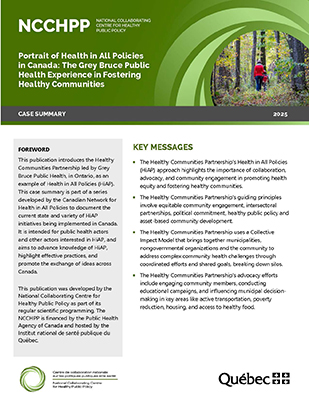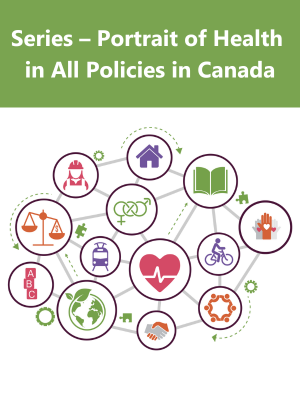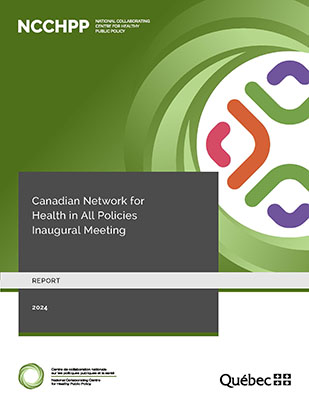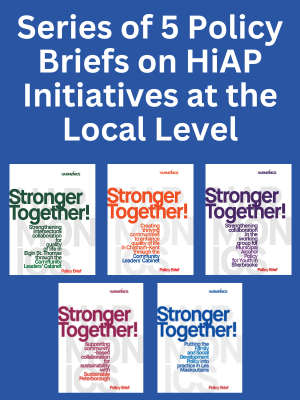Publications

Directory – Understanding Public Policy in Public Health: Resources for Knowledge and Competency Development
This directory presents a list of public policy resources designed to support the capacity development of public health professionals seeking to effectively contribute to the promotion and development of healthy public policies (HPPs).

Portrait of Health in All Policies in Canada: Advancing Public Health and Equity Through the Vancouver Coastal Health Healthy Public Policy Unit
This document presents the Healthy Public Policy Unit of Vancouver Coastal Health in British Columbia, as an example of a Health in All Policies (HiAP) approach. It is part of a series of case studies aimed at enhancing knowledge about HiAP, highlighting promising practices, and promoting the exchange of ideas across Canada.

Portrait of Health in All Policies in Canada: The Grey Bruce Public Health Experience in Fostering Healthy Communities
This document presents the Healthy Communities Partnership of Grey Bruce Public Health in Ontario, as an example of a Health in All Policies (HiAP) approach. It is part of a series of case studies aimed at enhancing knowledge about HiAP, highlighting promising practices, and promoting the exchange of ideas across Canada.

Portrait of Health in All Policies in Canada: Québec’s Collaborative Model for Health Prevention Governance
This document presents the Government of Québec’s Public Health Prevention Policy as an example of a Health in All Policies (HiAP) approach. It is part of a series of case studies aimed at enhancing knowledge about HiAP, highlighting promising practices, and promoting the exchange of ideas across Canada.

Series – Portrait of Health in All Policies in Canada
This series highlights a variety of Health in All Policies initiatives in Canada. Each case summary examines an initiative’s origins, mission, objectives, governance, implementation mechanisms, achievements, funding, and evaluation tools.

Guides and Resources Relevant to the Functioning and Governance of Canadian Municipalities, by Province and Territory
Canadian municipalities play a key role in local governance by collaborating with public health actors to improve living conditions and community well-being. To facilitate such collaboration, the NCCHPP has made available a selection of complementary guides and resources that can be accessed online and that provide details about the functioning of municipal administrations across Canada.

Infographic – How Can We Promote the Borrowing of a Public Policy Already Tested Elsewhere?
This infographic presents 4 categories of factors that public health actors can mobilize when considering proposing the adoption in their jurisdiction of public policies that have already been tested elsewhere.

Report of the Canadian Network for Health in All Policies Inaugural Meeting
This report provides an overview and a summary of the main discussions that took place during the inaugural meeting of the Canadian Network for Health in All Policies (CNHiAP), held on September 19 and 20, 2023, in Montréal.

Profiles of Public Health Systems in Canadian Provinces and Territories
The NCCHPP is publishing a series of profiles detailing public health systems in Canadian provinces and territories.

Stronger Together! Five Policy Briefs about Strengthening Implementation of Health in All Policies (HiAP) at the Local Level in Ontario and Québec
The HARMONICS research team has partnered with the NCCHPP to produce five policy briefs that feature a series of recommendations for implementing Health in All Policies at the local level.


